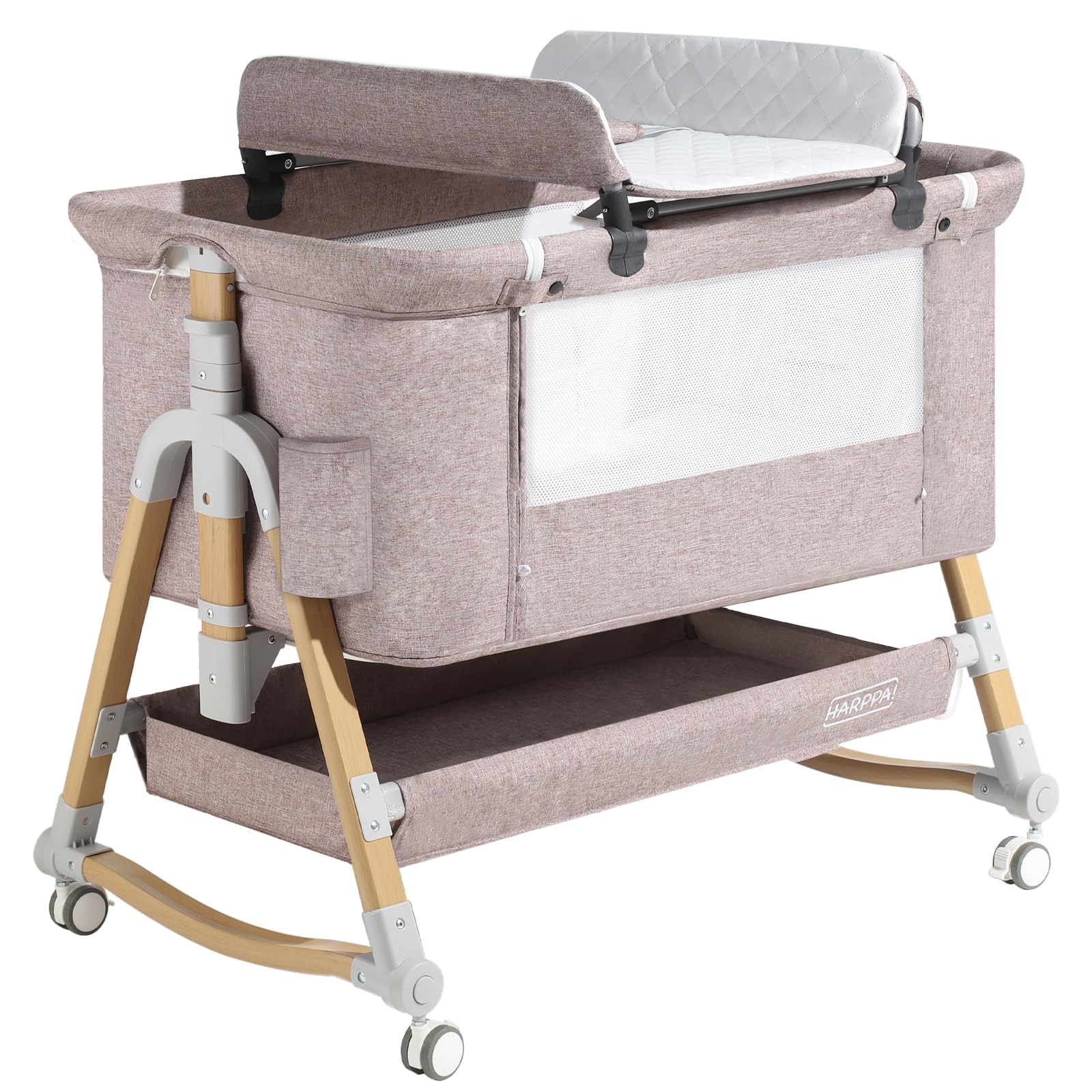How to Stop Baby Rolling in Cot: Proven Strategies
To stop a baby from rolling in the cot, transfer them from a bassinette to a cot when they show signs of being able to roll. Provide them with extra tummy time to strengthen their neck and upper body muscles, which will enable them to roll back over.
Always put the baby to sleep on their back, but if they roll onto their stomach, it’s fine to leave them in that position as long as their arms are free. If you’re uncomfortable with this, you can gently roll them onto their back again.
Ensure that the mattress is firm and flat, and there are no soft or loose objects in the cot. Sleep sacks are safe for babies who can roll over, but they won’t prevent rolling.
Understanding Why Babies Roll In Their Sleep
As your baby grows and develops, they may start to roll in their sleep. To prevent this, make sure the cot is clear of any loose objects and keep their sleeping space free of pillows and blankets. Giving them plenty of tummy time during the day can help strengthen their neck and upper body muscles, making it easier for them to roll back over.
Exploring The Reasons Behind Baby Rolling In Cot
When it comes to understanding why babies roll in their sleep, there are a few key reasons to consider. Firstly, rolling is a natural developmental milestone for babies as they begin to gain more control over their bodies. It is a sign that their muscles are getting stronger and they are becoming more mobile.
Secondly, babies may roll in their sleep as a way of exploring their surroundings. Rolling gives them the opportunity to move and see different things in their crib, which can be both exciting and stimulating for them.
Lastly, babies may roll in their sleep as a way of self-soothing. Rolling can provide them with comfort and help them find a position that feels more secure and cozy.
How Rolling Affects Baby’s Sleep Patterns
It’s important to understand how rolling can affect a baby’s sleep patterns. When babies start rolling, they may inadvertently wake themselves up during the night as they adjust their position. This can lead to frequent awakenings and disrupted sleep for both the baby and parents.
Additionally, rolling can also impact a baby’s ability to stay in a preferred sleep position. For example, if a baby prefers to sleep on their back but keeps rolling onto their stomach, this can cause concern for parents who are following safe sleep guidelines. It may require constant monitoring and intervention to ensure the baby is sleeping safely.
To prevent rolling from impacting a baby’s sleep patterns, parents can try implementing strategies to encourage the baby to stay in a desired sleep position. These strategies may include using sleep positioners or swaddling techniques to help restrict movement during sleep.
Creating A Safe Sleep Environment
Creating a safe sleep environment for your baby is essential to prevent them from rolling in the cot. Make sure to keep their sleeping space free of pillows and blankets, and ensure the mattress is firm and flat. Additionally, provide plenty of supervised tummy time to strengthen their neck and upper body muscles.
Ensuring A Firm And Flat Mattress
One of the key factors in creating a safe sleep environment for your baby is ensuring they have a firm and flat mattress to sleep on. A firm mattress helps to prevent the risk of suffocation and reduces the likelihood of your baby rolling in their cot. When choosing a mattress for your baby’s cot, look for one that is specifically designed for infants, as these are usually firmer and provide better support. It’s important to regularly check the mattress for any signs of wear and tear, and replace it if necessary.
Removing Any Loose Or Soft Items From The Cot
Another important step in creating a safe sleep environment is to remove any loose or soft items from your baby’s cot. This includes pillows, stuffed animals, blankets, and crib bumpers. These items can pose a suffocation hazard and increase the risk of your baby rolling in their sleep. Instead of using blankets, consider using a sleep sack or wearable blanket to keep your baby warm without the risk of covering their face. Keeping the cot free from loose and soft items reduces the chances of your baby getting tangled or trapped while they sleep.
Swaddling Techniques To Prevent Rolling
To prevent your baby from rolling in the cot, try swaddling techniques like the “sushi roll” where you wrap the baby snugly with a thin blanket, ensuring their arms are free. This helps babies feel secure and limits their ability to roll over while sleeping.
One effective method to prevent babies from rolling in their cot is through swaddling. Swaddling creates a cozy and secure environment that can help restrict their movements during sleep. However, it is important to learn the correct technique and choose the right swaddle for your baby’s comfort and safety. Here is a step-by-step guide to swaddling effectively:
Step-by-step Guide To Swaddling Effectively
- Select the right swaddle: Choose a swaddle blanket made of soft, breathable fabric that allows your baby’s skin to breathe. Make sure it is the appropriate size for your baby.
- Lay the swaddle: Spread the swaddle blanket on a flat surface, ensuring it forms a diamond shape.
- Fold the top corner: Fold the top corner down towards the center of the blanket. This creates a pocket to tuck your baby’s feet into.
- Place your baby: Lay your baby on their back on top of the swaddle, positioning their neck above the folded corner.
- Secure one arm: Take one side of the swaddle and bring it securely across your baby’s chest, ensuring their arm is tucked in close to their body.
- Secure the other arm: Take the remaining side of the swaddle and bring it across your baby’s chest, securing the other arm close to their body.
- Tuck the bottom: Fold the bottom of the swaddle up, covering your baby’s feet and ensuring their legs can still move slightly.
- Secure the swaddle: Use the Velcro or fabric fasteners on the swaddle blanket to secure it in place, making sure it is snug but not too tight.
Choosing The Right Swaddle For Your Baby
When it comes to choosing the right swaddle for your baby, there are a few important factors to consider:
- Fabric: Opt for swaddle blankets made of soft, breathable materials like organic cotton or muslin. These fabrics are gentle on your baby’s skin and promote airflow.
- Size: Ensure the swaddle is the appropriate size for your baby. It should be snug enough to prevent their limbs from escaping but not too tight that it restricts their movements or causes discomfort.
- Fastening mechanism: Look for swaddles with secure fastening mechanisms such as Velcro or sturdy fabric. This helps to keep the swaddle in place throughout the night.
- Ease of use: Consider swaddles that are easy to use and adjust, especially during late-night diaper changes. Zipper or snap closures can make the process more convenient for you and your little one.
By following these swaddling techniques and choosing the right swaddle, you can provide a secure and comfortable sleep environment for your baby while reducing the risk of rolling in the cot. Remember to always follow safe sleep guidelines and supervise your baby during swaddling.
Transitioning From Swaddling To Independent Sleep
Transitioning from Swaddling to Independent Sleep can be a challenge when it comes to stopping baby from rolling in the cot. To prevent this, give your baby extra tummy time to develop stronger muscles and consider transferring them to a cot when they start showing signs of rolling.
Gradually Transitioning Your Baby Out Of Swaddling
When it comes to transitioning from swaddling to independent sleep, it’s important to take it slow and gradually introduce your baby to the new sleep environment. Abruptly stopping swaddling can cause feelings of insecurity and discomfort for your little one, which can lead to difficulties in falling asleep and staying asleep. To start the transitioning process, consider the following steps:- Start by swaddling your baby with one arm out: This allows your baby to get used to the feeling of having one arm free while still having the security of being swaddled. If your baby shows signs of distress, you can always swaddle both arms and try again the following day.
- Transition to both arms out: Once your baby is comfortable with one arm out, you can gradually transition to having both arms out of the swaddle. This helps your baby develop the necessary motor skills and coordination to soothe themselves to sleep.
- Experiment with new sleepwear: As you phase out swaddling, you can try using sleep sacks or wearable blankets. This provides a sense of security while allowing your baby to move their arms and legs freely. Ensure that the sleepwear is appropriately sized and follows safety guidelines.
- Offer comfort and reassurance: During the transition period, it’s crucial to provide your baby with extra comfort and reassurance. This can include gentle rocking, soothing sounds, or using a favorite blanket or stuffed animal.
Introducing Self-soothing Techniques
To encourage independent sleep, it’s essential to introduce self-soothing techniques to your baby. These techniques allow your baby to learn how to calm themselves down and fall asleep without relying on external assistance. Some self-soothing techniques you can try include:- Use a pacifier: Offering a pacifier can provide comfort and help your baby relax. However, ensure that the pacifier is safe and age-appropriate.
- Establish a bedtime routine: Consistency is key when it comes to bedtime routines. Creating a soothing routine before sleep, such as a warm bath, gentle massage, or reading a bedtime story, can signal to your baby that it’s time to wind down.
- Encourage tummy time during awake hours: Tummy time not only helps strengthen your baby’s muscles but also allows them to explore their surroundings. This exploration contributes to their overall development and can tire them out, making it easier for them to settle down for sleep.
- Implement a gentle sleep training method: If your baby is having difficulty falling asleep or staying asleep, implementing a gentle sleep training method can be beneficial. These methods involve gradually reducing your involvement in the falling asleep process, such as slowly decreasing the amount of time you spend rocking or holding your baby before sleep.
Encouraging Back Sleeping Habits
To encourage back sleeping habits and prevent baby from rolling in the cot, try gently rolling them back onto their back whenever they roll over. Providing tummy time during the day can also help strengthen their neck and upper body muscles, making it easier for them to roll back over.
Remember to always place baby on their back to sleep and ensure a firm and flat mattress without any loose objects in the cot.
Techniques To Encourage Your Baby To Sleep On Their Back
Encouraging your baby to sleep on their back is important for their safety and well-being. Here are some techniques you can use to encourage your baby to sleep in this position:
- Start early: It is best to start encouraging back sleeping habits right from birth. Make it a routine to lay your baby down on their back for naps and bedtime.
- Choose the right mattress: Ensure the mattress is firm and flat, which provides proper support to your baby’s back and neck.
- Remove all loose items: Keep the cot free from any soft or loose items that may pose a suffocation hazard. This includes pillows, stuffed animals, and thick blankets.
- Use a sleep sack: Consider using a sleep sack instead of loose blankets. Sleep sacks provide a cozy and safe environment for your baby while keeping them warm without the risk of suffocation.
- Offer tummy time during awake hours: Giving your baby supervised tummy time during awake hours helps them develop stronger neck and upper body muscles, making it easier for them to roll back onto their back.
- Stay consistent: Be consistent with back sleeping, even if your baby rolls onto their stomach during sleep. Gently roll them back onto their back if you feel uncomfortable leaving them in the stomach position.
Benefits Of Back Sleeping For Baby’s Safety
Sleeping on the back provides numerous benefits for your baby’s safety and reduces the risk of Sudden Infant Death Syndrome (SIDS). Here are some benefits of back sleeping:
- Reduced risk of SIDS: Placing your baby on their back to sleep significantly reduces the risk of SIDS. This sleeping position allows for better airflow and prevents obstructions in the airway.
- Better temperature regulation: Back sleeping helps your baby regulate their body temperature more effectively, reducing the risk of overheating.
- Prevents flat head syndrome: Sleeping on the back helps distribute the pressure on your baby’s head evenly, reducing the risk of developing a flat spot.
- Facilitates motor development: Back sleeping allows your baby to have more freedom of movement and encourages them to explore different motor skills, such as rolling over and sitting up.
- Enhanced digestion: Sleeping on the back helps prevent the regurgitation of stomach contents, reducing the risk of choking and acid reflux.
By implementing these techniques and understanding the benefits of back sleeping, you can promote a safe and restful sleep environment for your baby.
:max_bytes(150000):strip_icc()/travel-strollers-overhaul-tout-810cd97fb3934d65a0088f3103bdd595.jpg)
Credit: www.verywellfamily.com
Frequently Asked Questions Of How To Stop Baby Rolling In Cot
Why Do Babies Move To Cot When Rolling?
When babies start rolling, it’s time to move them to a cot. Give them extra tummy time to strengthen their muscles. Always put them to sleep on their back, but if they roll onto their stomach, it’s fine as long as their arms are free.
Keep their sleeping space safe and remove any loose objects.
What To Do If My Baby Rolls Over While Sleeping?
If your baby rolls over while sleeping, it is generally safe to leave them in that position as long as their arms are free. However, if you feel uncomfortable, gently roll them back onto their back. Make sure the mattress is firm and flat, and remove any soft or loose objects from the crib.
Always place your baby on their back to sleep. Avoid using sleep sacks as they won’t prevent rolling over.
How Do I Stop My Baby From Rolling On His Face At Night?
To stop your baby from rolling on their face at night, make sure the mattress is firm and flat and remove any soft or loose items from the cot. Always place your baby on their back to sleep. If you see your baby on their face, gently turn them onto their back again.
Do Sleep Sacks Prevent Babies From Rolling Over?
Sleep sacks do not prevent babies from rolling over. While sleep sacks keep babies safe from loose blankets and reduce the risk of SIDS, they won’t stop rolling. It’s important to ensure a safe sleeping environment and place the baby on their back to sleep.
Conclusion
When your baby starts rolling in their cot, it’s important to ensure their safety and comfort while sleeping. Transition them from a bassinet to a cot when they show signs of rolling. Provide plenty of supervised tummy time during the day to strengthen their muscles.
Always place them on their back to sleep and avoid loose bedding. Remember, it’s perfectly fine for your baby to sleep on their stomach if they roll onto it, as long as their arms are free.








